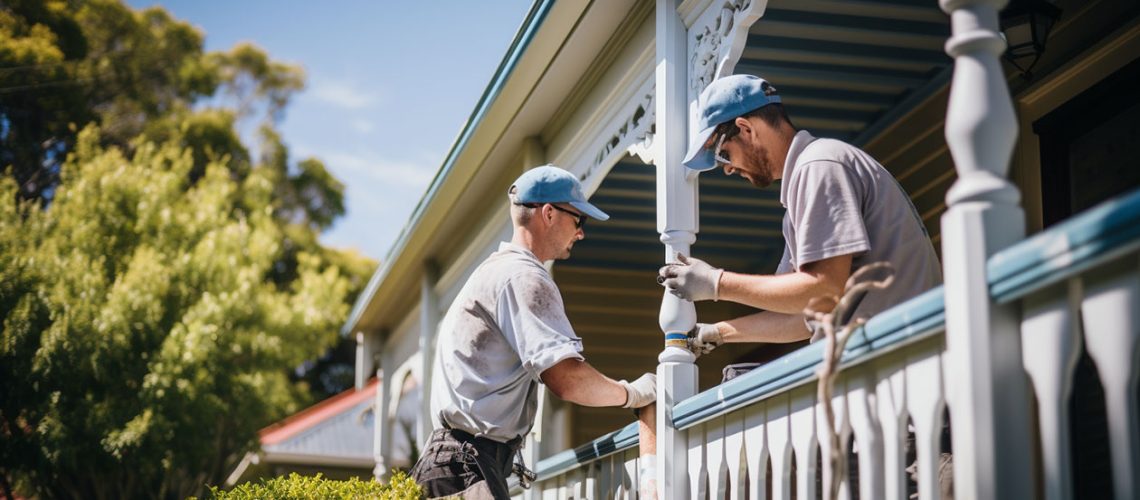Understanding the lifespan of exterior house paint is crucial for homeowners looking to embark on a painting project. The longevity of paint directly affects the appearance and protection of your home’s exterior, making it essential to choose the right product and plan accordingly. By considering how long exterior house paint lasts, homeowners can ensure that their investment in a painting project is both cost-effective and aesthetically pleasing in the long run.
Factors Affecting the Lifespan of Exterior House Paint
A properly painted exterior not only enhances the curb appeal of your house but also protects it from various elements. However, the lifespan of exterior house paint can vary depending on several factors, including the type of paint or exterior wall coating used.
Climate and Weather Conditions
In regions with high temperatures and humidity, exterior paint can deteriorate faster. The heat can cause paint to fade or crack, while excessive moisture can lead to mould or mildew growth.
Harsh winter conditions with freezing temperatures, frost, and heavy snowfall can take a toll on exterior paint. The moisture from melting snow can seep into the paint, causing it to blister or peel.
Continuous exposure to rain and high moisture levels can impact the longevity of exterior paint. Excessive moisture can cause the paint to bubble, crack, or peel off over time.
Surface Preparation
Properly preparing the surface before painting is crucial for the longevity of the paint. Removing dirt, dust, and old paint ensures a clean and smooth surface for better adhesion.
Applying a primer and filling any cracks, holes, or damaged areas helps create a uniform surface for the paint. This prevents moisture from seeping into the walls and extends the lifespan of the paint.
The texture and smoothness of the surface play a significant role in paint adhesion and durability. Rough or uneven surfaces may result in poor paint adhesion and reduce the lifespan of the paint.
Quality of Paint and Materials
Investing in high-quality paint brands can significantly increase the lifespan of exterior house paint. These paints are formulated with superior ingredients that offer better protection against fading, cracking, and weathering.
Different paint formulations, such as acrylic, latex, or oil-based, have varying durability. Understanding the specific requirements of your house and choosing the appropriate paint can help extend its lifespan. According to a study by Christopher, K., Pal, A., Mirchandani, G., & Dhar, T. (2014) on Synthesis and characterization of polystyrene-acrylate/polysiloxane (PSA/PSi) core shell polymers and evaluation of their properties for high durable exterior coatings. – Exterior paints prepared using the hybrid polymers as binders exhibited superior performance properties like weather ability and dirt pick-up resistance.
Using the right materials and tools during the painting process can affect the overall quality and longevity of the paint. High-quality brushes, rollers, and other equipment ensure proper application and enhance the durability of the paint.
Different Types of Exterior House Paint Finishes and Their Durability
Flat Paint Finish
Flat paint finish is a popular choice for exterior surfaces due to its matte appearance. However, it has its own set of pros and cons.
- Pros: Flat paint helps to hide surface imperfections and provides a smooth finish. It is also less reflective, making it ideal for older homes or surfaces with irregular textures.
- Cons: One major drawback of flat paint is that it tends to be less resistant to stains and dirt. It can also be difficult to clean, and its durability is affected by exposure to harsh weather conditions.
The expected lifespan of flat paint on exterior walls and surfaces can vary depending on several factors, such as climate, maintenance, and quality of paint used. On average, flat paint can last around 3-7 years before showing signs of wear and fading.
Satin or Eggshell Finish
Satin or eggshell finishes are slightly more durable than flat paint finishes and offer a subtle sheen. These finishes have their own unique characteristics and benefits.
Satin or eggshell finishes:
- Provide a soft and velvety appearance to surfaces.
- Have a slight sheen that adds depth to the colour.
- Are more resistant to stains and easier to clean compared to flat paint.
- Offer better durability in various weather conditions, making them suitable for exterior applications.
Semi-Gloss and Gloss Finishes
Semi-gloss and gloss finishes are the most durable paint finishes for exterior walls and surfaces. They have their own advantages and disadvantages.
Advantages:
- Highly resistant to stains, dirt, and moisture.
- Easy to clean and maintain.
- Provide a vibrant and shiny appearance to surfaces.
Disadvantages:
- Due to their reflective nature, gloss finishes tend to highlight surface imperfections.
- May require added surface preparation for an optimal finish.
- Can show brush marks or roller marks if not applied properly.
The longevity of semi-gloss and gloss finishes on exterior walls can vary, but they generally last longer than flat or satin finishes. With proper maintenance and regular cleaning, these finishes can maintain their appearance for 5-10 years or even longer.
Recommended Duration for Repainting Exterior House
A well-maintained exterior paint job not only enhances the aesthetic appeal of your house but also protects it from harsh weather conditions and other external factors. However, even the highest quality paint will eventually wear off, fade, or become dull over time. So, how often should you repaint your exterior house? Let’s dive into some general guidelines and industry standards to help you determine the recommended duration for repainting.
General Guidelines and Industry Standards
- Climate: Extreme weather conditions such as heavy rainfall, strong winds, excessive heat, or freezing temperatures can accelerate paint deterioration. If you reside in an area with harsh weather, you may need to repaint more frequently.
- Quality of previous paint job: The durability and longevity of your current paint job play a significant role in determining when to repaint. High-quality paint, proper surface preparation, and professional application can extend the lifespan of your paint.
- Exposure to sunlight: Continuous exposure to UV rays can cause paint to fade and degrade over time. Houses located in sunny regions may require repainting more frequently compared to those in shaded areas.
- Maintenance: Regular maintenance practices such as cleaning, inspecting for signs of damage, and timely spot repairs can help prolong the life of your exterior paint.
Common repainting intervals for different climate regions:
- Tropical and humid regions: These areas typically experience high levels of humidity, intense heat, and frequent rain. Repainting every 3 to 5 years may be necessary to combat the effects of moisture and prevent paint deterioration.
- Temperate regions: Regions with moderate climates often require repainting every 5 to 7 years. However, factors such as sun exposure and regular maintenance could influence this timeframe.
- Arid and dry regions: In drier climates, where extreme heat and lack of moisture are prevalent, exterior paint may last 7 to 10 years. Nonetheless, it’s essential to monitor signs of paint deterioration and adjust the timeframe accordingly.
Individual Variables for Repainting
- Cracking or peeling: If you notice cracking or peeling of the paint surface, it is an indication that repainting is necessary. Ignoring these signs could lead to further damage and higher costs.
- Colour fading: Over time, exposure to sunlight can cause the colour of your exterior paint to fade. If your house appears dull or discoloured, consider repainting to restore its vibrancy.
- Mould or mildew growth: If mould or mildew is present on your exterior walls, it’s crucial to address the underlying moisture issue, remove the growth, and repaint the affected areas to prevent further damage.
Factors that may necessitate more frequent or less frequent repainting:
- Surface quality: The condition of your exterior walls, including any cracks, damages, or uneven surfaces, can impact the longevity of your paint job. Repairing and preparing the surfaces properly before repainting can help extend their lifespan.
- Colour choice: Darker colours tend to fade faster than lighter ones due to increased absorption of heat and UV rays. If you opt for a dark-coloured exterior paint, be prepared for more frequent repainting.
- Changes in personal preference: Sometimes, homeowners may choose to repaint their houses simply because they desire a different colour or finish. While this is not necessary in terms of paint deterioration, it ultimately depends on personal aesthetic preferences.
As every home and its environment are unique, it is essential to assess your specific circumstances and consult with a professional to determine the most appropriate repainting duration for your exterior house.
Expert Advice and Professional Tips for Maximizing Exterior House Paint Lifespan
Hiring a Professional Painting Contractor
When it comes to maximising the lifespan of your exterior house paint, hiring a professional painting contractor is crucial. These experts have the necessary knowledge and experience to ensure a long-lasting and high-quality paint job.
With their expertise, they can accurately assess the condition of your house’s exterior and recommend the appropriate preparation and painting techniques. They also have access to top-notch tools and paints, which further contribute to the lifespan of the paint.
How professionals ensure longer-lasting paint jobs
Professional painting contractors follow a systematic approach to ensure the longevity of your exterior house paint. They begin by thoroughly washing and preparing the surface, removing any dirt, grime, or loose paint.
They then apply high-quality primers and sealers to create a strong foundation for the paint. This prevents moisture from seeping into the surface and causing damage. Additionally, professionals carefully apply multiple coats of paint to ensure proper coverage and protection against the elements.
By employing these techniques, professional painters can significantly extend the lifespan of your exterior house paint, saving you time and money in the long run.
Understanding the Role of Colour Choice
Maz Nazzimi, a professional painter from Dupaint says “Believe it or not, colour choice plays a critical role in the lifespan of your exterior house paint. Some colours are more prone to fading and deterioration due to their chemical composition and susceptibility to ultraviolet (UV) rays. Dark colours, such as deep blues and blacks, tend to absorb more heat from the sun, which can cause the paint to break down faster. On the other hand, lighter colours tend to reflect sunlight, reducing the risk of fading and extending the lifespan of the paint.”
If you want to maximise the lifespan of your exterior house paint, consider opting for lighter colours that are known for their UV resistance. Shades of whites, beiges, and pastels not only provide a timeless aesthetic but also offer better protection against the elements.
Additionally, consider choosing paints with built-in UV blockers and protective additives. These additives act as a shield, preventing the sun’s harmful rays from breaking down the paint’s pigmentation and integrity.
By taking colour choice into account, you can ensure that your exterior house paint lasts longer and maintains its vibrancy for years to come.

